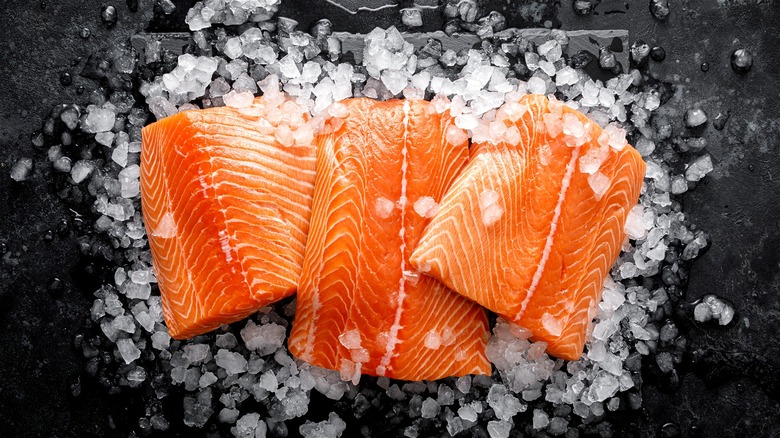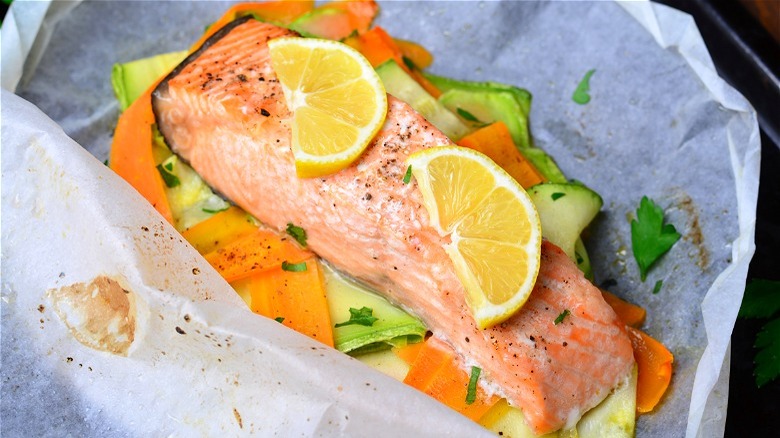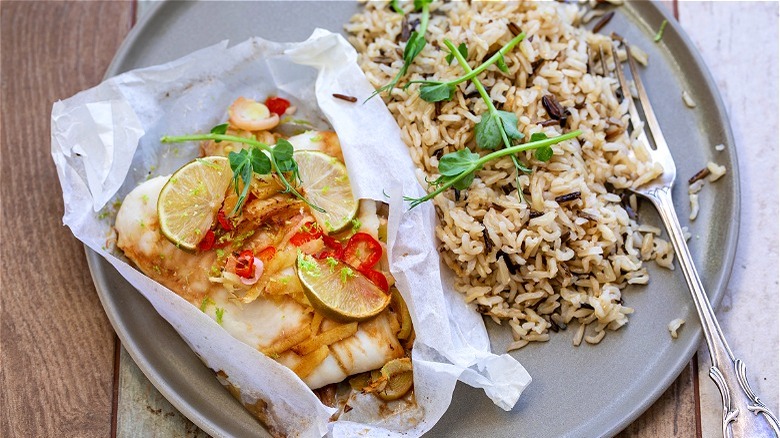The Easiest Way To Cook Fish For A Stress-Free Weeknight Meal
As much as we'd all like to live in a world where weeknight dinners are planned ahead of time, the reality for some of us almost always includes last-minute preparation. According to a 2022 national survey conducted by MyProtein, even though dinner is statistically the most planned meal of the day, only 43.6% of more than 3,000 participants admit to meal planning on a consistent basis. That leaves more than half of the respondents regularly scrambling to get dinner on the table promptly.
Instead of meticulously planning every meal down to pre-portioned spices, some of us like to buy an array of colorful produce and protein options and come up with evening dishes on a whim. Besides chicken, beef, and tofu, physician nutrition specialist Janese Laster said to The Washington Post in 2019 that fish is one of the most nutritious animal proteins you can eat. Not only is fish a great source of omega-3 fatty acids, but indulging in a weekly helping of fish provides your body with ample amounts of vitamin D, phosphorus, and magnesium.
And whether you choose to cook up a filet or two of salmon, cod, or halibut, having a go-to preparation method will make your weeknight dinners a little less stressful. Among the most common ways to cook fish, what's the easiest method of preparation that doesn't skimp on flavor but provides the added benefit of a lighter post-dinner clean-up?
The efficient, impressive way to cook fish
Even though consistent consumption of fish has innumerable health benefits, one 2019 survey conducted by The Food Marketing Institute discovered that 28% of more than 2,000 participants shy away from buying seafood because they lack confidence in preparing the water-derived fare (via SeafoodSource). While there are many ways to cook fish such as frying, sautéeing, or roasting, cooking fish in liquid or poaching may be the most approachable and convenient method when you're pressed for time after a long Wednesday at the office.
The cooking method known as en papillote has been around since the mid-19th century, when French chef Antoine Alciatore invented the method to impress dinner guests in his brand-new restaurant. Originally created to mimic a hot air balloon, en papillote means to cook indirectly through steam that has been created by enclosing food in a packet of oven safe paper or foil.
One of the added benefits of cooking this way is that you can add your favorite thinly sliced vegetables or cooked grain directly to the enclosed packet to make an all-in-one meal. (Just make sure to choose quicker-cooking vegetables such as spinach or zucchini.) Cooking fish en papillote is a sheet-pan meal simplified. And with a bit of guidance, you'll be on your way to making an impressive meal with few ingredients and little prep time.
Tips for cooking perfectly poached fish
Most home chefs are always looking for that perfect foolproof method for getting parchment paper to lay flat. But when you make fish en papillote, you can utilize parchment's rolled edges to create a loosely sealed packet that cooks your dinner without drying out the contents.
To streamline the process, use large enough sheets and cut parchment paper in a heart shape, meeting one side to the other so you can fold up the edges without parts of your dinner seeping out. Just make sure to add a bit of fat and always add a bit of liquid to the paper or foil before sealing. Even though your enclosed meal will release juices during the cooking process, an extra addition, such as lemon juice or coconut milk, can create a nuanced flavor profile that brings the entire dish together.
Most cooking instructions also recommend choosing fish that doesn't exceed one inch in thickness to ensure tender, evenly cooked protein. If you want to make a presentation out of this convenient dish, serve individual parchment packets on plates so your dinner guests can reveal the soon-to-be-devoured meal themselves. Of the many benefits cooking en papillote brings, you can lean into this style of cooking if you're pressed for time. Once your fish is in the oven, you can clean the mess you've already made. After dinner has been happily eaten, simply throw the leftover parchment packets in the trash.


